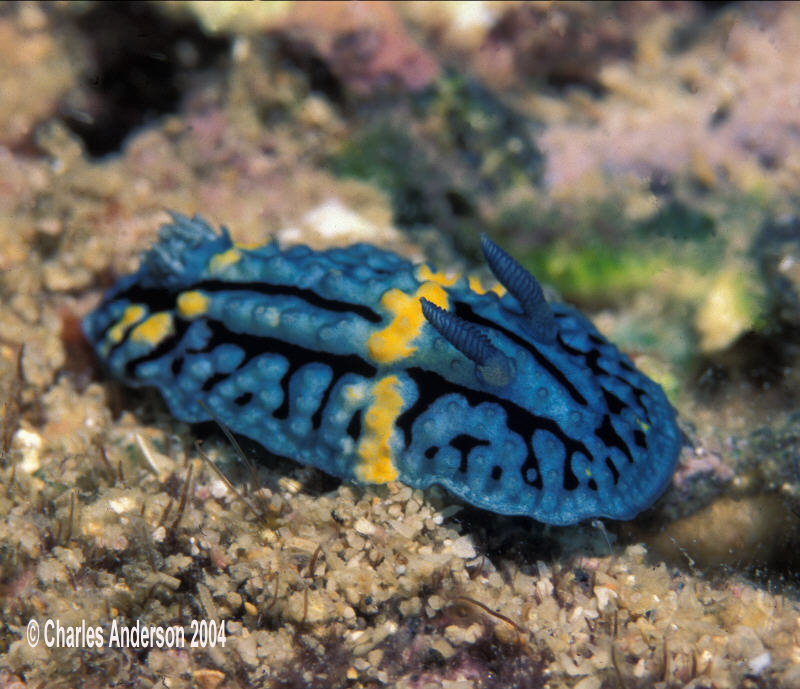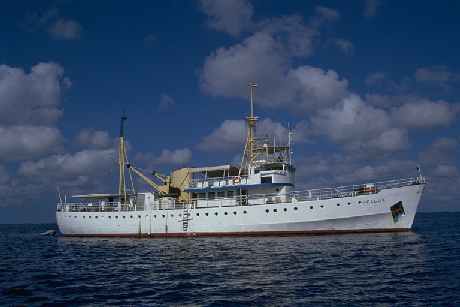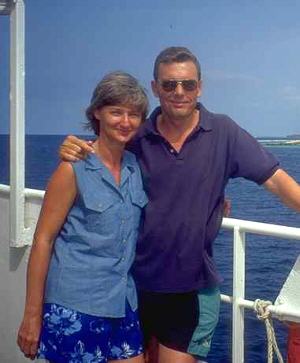 |
Aldisa andersoni
Pigeon Island, Trincomal, Sri Lanka
Photo courtesy of Charles Anderson
 |
Aldisa andersoni Gosliner and Behrens, 2004 When Debelius' Nudibranch and Sea Snails was published back in 1998 we noticed a fantastic, blue dorid, tentatively identified as an undescribed Chromodoris on page 213. We also noticed that the photographer who took the shot was good friend Charles Anderson, who operates, The Whale and Dolphin Company , in the Maldives aboard the 150 foot ship - M.V. Pollux. Well we sent off an e-mail immediately saying - "Hey Chas, do you have any specimens." Luckily he did. In addition to being a remarkable blue color, it appears to mimic species of the Phyllidia. A few years later and this species now carries his name. Millen & Gosliner (1985) defined the diagnostic characters of the genus Aldisa, listing eleven species. The genus is characterized by having elongate denticulate teeth, penial spines, conical tubercles and absence of oral tentacles. Several additional species have been added since then (Ortea & Ballesetros, 1998; Elwood et al., 2000; Perrone, 2001). All but four of these species are white, yellowish or red in color. To paraphrase Dr. Bill Rudman (Sea Slug Forum, March 13, 2002), we too "used to think of Aldisa as a genus of red dorids which mimicked sponges, but now it seems they include a group of nodulose species which mimic phyllidiids." |
Aldisa andersoni is known only from Pigeon Island, Trincomal, Sri Lanka. It is one of four blue colored species of Aldisa , with black and/or yellow markings. The living animals are 20-30 mm in length. The body is oval and the notal surface covered with a series of low conical tubercles. The tubercles form distinct ridges running longitudinally along the center of the notum, and perpendicular laterally along the margin of the notum. Rows of these tubercles are situated in regions of opaque blue pigment. These regions are separated by areas of black. There is an opaque, bright yellow saddle across the notum behind the rhinophores. This saddle extends right to the edge of the mantle. A few bright yellow patches may partially encircle the gill pocket. Some specimens have yellow patches posterior to the rhinophores.
It is similar in coloration to Aldisa albatrossaeisi , Aldisa williamsi , and A. erwinkoehleri , but differs in a number of characteristics. In Aldisa andersoni , the low conical tubercles are clearly arranged in rows or ridges. Tubercles on the notum of Aldisa albatrossae, A. williamsi and A. erwinkoehleri are randomly distributed. The black coloration on A. williamsi and A. erwinkoehleri forms concentric rings, and in A. albatrossae forms a rectangle on the dorsum with a T-shape mark anterior to the rhinophores. In A. andersoni, the black pigmentation is found uniformly over the mantle separating the rows of tubercles. The opaque yellow pigmentation on Aldisa andersoni is quite similar to that found on A. albatrossae and A. erwinkoehleri. There are however consistent differences which clearly separate them. A. williamsi has no yellow pigmentation. The yellow pigmentation covers the tubercles in A. erwinkoehleri and in A. andersoni, but not in A. albatrossae, where it occurs between the tubercles. The yellow color markings on A. andersoni are far more extensive than in the other species, with a yellow saddle extending to the very edge of the mantle that is not isolated into smaller broken patches, as in A. erwinkoehleri.
The rhinophores differ in color between all four species. In A. albatrossae they are white-grey; in A. williamsi pale brown; in A. erwinkoehleri black while in A. andersoni they are the same blue as the body. The arrangement of tubercles around the rhinophoral pockets differs among the four species. Aldisa albatrossae has four similarly sized equally separated tubercles; A. erwinkoehleri has two large and two small tubercles while A. andersoni and A. williamsi have two equally sized tubercles, separated on either side of the pocket. Differences exist also in the tubercles around the gill sheath. A. albatrossae has a double row of tubercles; A. williamsi has a single row of eight tubercles; A. erwinkoehleri a single series tubercles while A. andersoni has a single series of twelve tubercles around the sheath.
There are several examples of cryptobranch dorid nudibranchs (these Aldisa's and Chromodoris geometrica ) looking remarkably similar to Phyllidid nudibranchs. Whether this is a case of mimicry or coincidence has not been proven, but we tend to side with an argument for Mullerian mimicry, as all these species benefit collectively by close resemblance as they all have mantle glands which produce noxious chemicals for protection.
References:
Elwood, H.R., Valdés, A. & Gosliner, T.M. 2000. Two new species of Aldisa Bergh, 1878 (Mollusca, Nudibranchia) from the tropical Indo-Pacific. Proceedings of the California Academy of Sciences, 52(14): 171-181.
Gosliner, Terrence M. & David W. Behrens. 2004. Two of New Species of Dorid Nudibranchs (Gastropoda, Opisthobranchia) from the Indian Ocean. Proc. Calif. Academy of Sci. 55(1): 1-10.
Ortea, J. & M. Ballesteros. 1989. Descripcion de una espectacular especie del genero Aldisa Bergh, 1878 (Mollusca, Opisthobranchia) dedicada a la memoria Dr. Giorgio Barletta. Bollettino Malacologico 24 (9-12): 155-160.
Perrone, Antonio S. 2001. A new species of Nudibranchia of the genus Aldisa Bergh (Gastropoda, Opisthobranchia) from Thailand. Basteria 65: 105-11
Danville, Calif
May, 2004
Dr. Charles Anderson and wife Sue
 |
I am a British marine biologist and have lived and worked in the Maldives since 1983. During that time my main research interests have been related to fish and fisheries. However, I am fascinated by all aspects of natural history, including cetaceans, seabirds, flatworms and of course Opisthobranchs. I started diving in 1975, in the cold waters of the North Sea off Scotland and became enthralled by sea slugs from the very start. I started underwater photography when I moved to the Maldives, and have since published a series of five small guides to marine life of the islands (and two other books on marine life of Indonesia and fishes of Sri Lanka). With my wife Sue I have also started a whale watching company in order to conduct research on the remarkably diverse cetacean fauna of the Maldives.
Send Charles email at anderson@dhivehinet.net.mv
|
Taxonomic information courtesy of:

David W. Behrens
Author:
Pacific Coast Nudibranchs
Send Dave mail at dave@seachallengers.com
|
